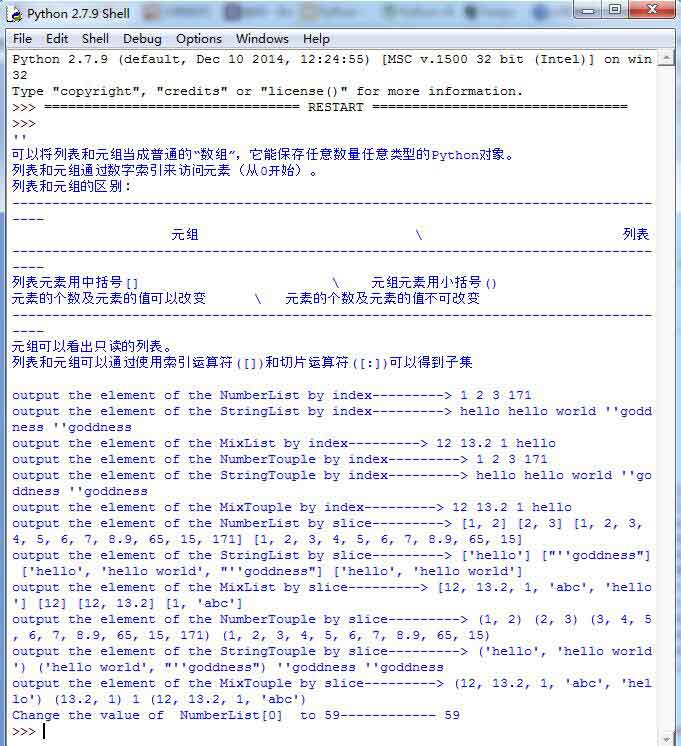本文实例讲述了Python列表和元组的定义与使用操作。分享给大家供大家参考,具体如下:
|
1
2
3
4
5
6
7
8
9
10
11
12
13
14
15
16
17
18
19
20
21
22
23
24
25
26
27
28
29
30
31
32
33
34
35
36
|
#coding=utf8print '''''可以将列表和元组当成普通的“数组”,它能保存任意数量任意类型的Python对象。列表和元组通过数字索引来访问元素(从0开始)。列表和元组的区别:------------------------------------------------------------------------------------ 元组 \ 列表------------------------------------------------------------------------------------列表元素用中括号[] \ 元组元素用小括号()元素的个数及元素的值可以改变 \ 元素的个数及元素的值不可改变------------------------------------------------------------------------------------元组可以看出只读的列表。列表和元组可以通过使用索引运算符([])和切片运算符([:])可以得到子集'''NumberList=[1,2,3,4,5,6,7,8.9,0101,017,0xab]StringList=['hello',"hello world",'''''goddness''']MixList=[12,13.2,01,'abc','hello']NumberTouple=(1,2,3,4,5,6,7,8.9,0101,017,0xab)StringTouple=('hello',"hello world",'''''goddness''')MixTouple=(12,13.2,01,'abc','hello')print "output the element of the NumberList by index--------->",NumberList[0],NumberList[1],NumberList[2],NumberList[-1]print "output the element of the StringList by index--------->",StringList[0],StringList[1],StringList[2],StringList[-1]print "output the element of the MixList by index--------->",MixList[0],MixList[1],MixList[2],MixList[-1]print "output the element of the NumberTouple by index--------->",NumberTouple[0],NumberTouple[1],NumberTouple[2],NumberTouple[-1]print "output the element of the StringTouple by index--------->",StringTouple[0],StringTouple[1],StringTouple[2],StringTouple[-1]print "output the element of the MixTouple by index--------->",MixTouple[0],MixTouple[1],MixTouple[2],MixTouple[-1]print "output the element of the NumberList by slice--------->",NumberList[0:2],NumberList[1:3],NumberList[0:],NumberList[:-1]print "output the element of the StringList by slice--------->",StringList[0:1],StringList[2:3],StringList[0:],StringList[:-1]print "output the element of the MixList by slice--------->",MixList[0:],MixList[:1],MixList[0:2],MixList[2:-1]print "output the element of the NumberTouple by slice--------->",NumberTouple[0:2],NumberTouple[1:3],NumberTouple[2:],NumberTouple[:-1]print "output the element of the StringTouple by slice--------->",StringTouple[0:2],StringTouple[1:3],StringTouple[2],StringTouple[-1]print "output the element of the MixTouple by slice--------->",MixTouple[0:],MixTouple[1:3],MixTouple[2],MixTouple[:-1]NumberList[0]=59#NumberTouple[0]=56print "Change the value of NumberList[0] to 59------------",NumberList[0]#print "Can not change the value of NumberTouple[0] to 56------------",NumberTouple[0] |
运行结果:

希望本文所述对大家Python程序设计有所帮助。










